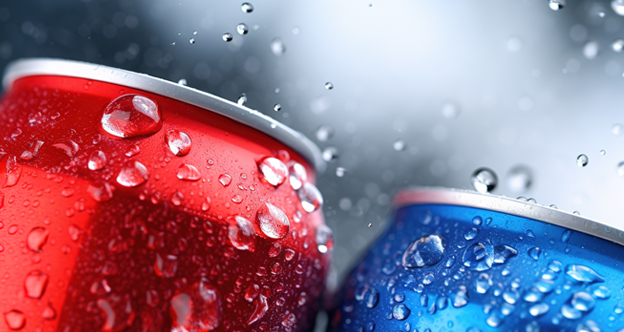What is Blue Ocean Leadership?
Recently, we introduced you to Blue Ocean Leadership with our analysis of the Starbucks Case.
If you have missed it, check it out here: https://ezyspark.com/blue-ocean-leadership-the-starbucks-case/
To recap, Blue Ocean Leadership (BOL) is a systematic leadership approach that focuses on leadership acts and activities at each level of an organisation. BOL is applied through very specific tools, with the ambitious aim to unleash oceans of untapped talent, boost employees’ motivation, and improve business results.
In this new series of case study, we will enlighten you with a comparison between the two giants of soft drinks, The Coca-Cola Company and PepsiCo. Their respective CEOs, Muhtar Kent, and Indra Nooyi, will be X-rayed through the BOL tools within an innovative action-based approach that focuses on their acts and activities.
Muhtar Kent: 2020 Vision
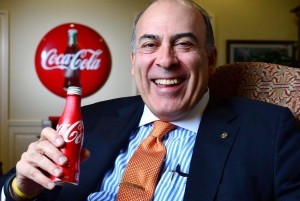
Son of a Turkish diplomat, Muhtar Kent was appointed as Chief Executive Officer of The Coca-Cola Company in 2008. When he first took over the company, Kent developed a new company vision – 2020 Vision. His ambitious objective was to more than double the company revenues by means of improving daily servings of Coca-Cola products from 1.9bn to 3bn in 2020.
New Values, New People
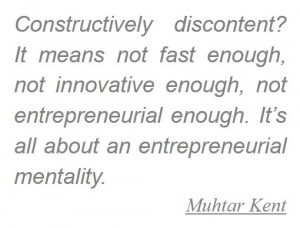
Kent’s first step to achieve the 2020 Vision has been to replace almost 70% of the senior managers by filling the ranks with operators who, he says, “know how to generate results.” He also tried to rejuvenate the inward-looking and “arrogant” corporate culture. He gathered the top 400 managers from all over the World to talk about their experiences and their opinions about the future developments of the Company. He also conducted private meetings with people from different management levels to collect different ideas. Applying his philosophy of “constructively discontent”, Kent leads his employees by example. To reverse the spread attitude toward overspending, he introduced a rule according to which managers must pay $15 monthly if they use their phones for personal calls. Of course, Kent pays his $15 regularly. In the company, he is known to avoid credit cards in order to “feel the cash” and to always turn off the lights to reduce waste.
No More Waste
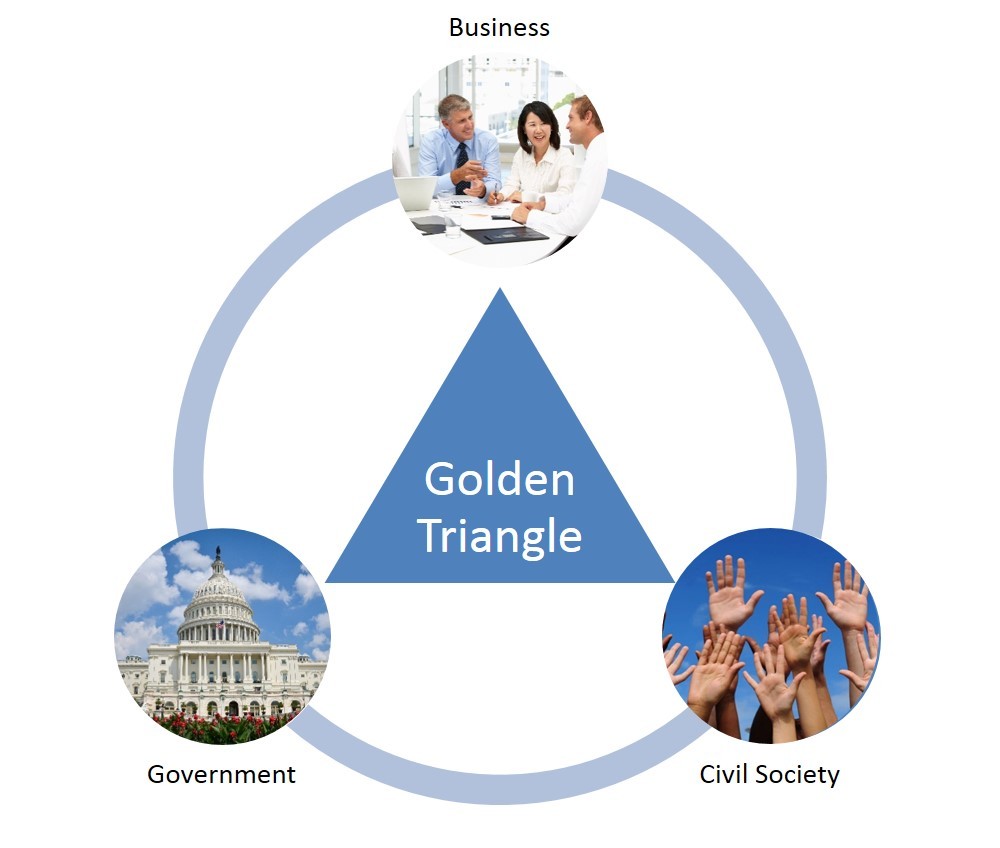
Kent also emphasized corporate social responsibility in environmental and gender issues. He developed strategic partnerships with different organisations across business, government, and civil society. One of the pivotal points of the 2020 Vision is the so-called water neutrality. The Company’s objective is to return to the World the amount of water used in their production through replenishment projects. For example, increasing water efficiency in its plants and returning water to watersheds and municipalities through wastewater treatment. In 2014, the Company managed to cover 94% of the water used, but Kent is confident it to reach 100% coverage before 2020. In terms of gender issues, with the programme “5 by 20” The Coca-Cola Company aims to empower 5 million women entrepreneurs by 2020.
Who Does Not “Like” Coca-Cola?
Always aware about most recent trends, Kent identified in the digital marketing the key factor for a sustainable success. Even during the darkest years of the crisis, Kent increased promotional spending, while other companies cut back on advertising and marketing. With almost 100 million likes, Coca-Cola’s Facebook page is the largest consumer-brand fan page within the social network. On Twitter, Coca-Cola developed customised emojis, known as “hash flags”, available for special events.
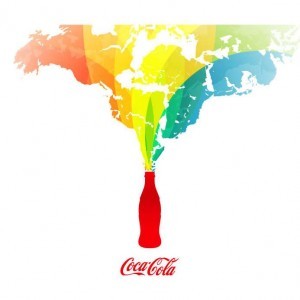
Together We Can
The Austrian economist Peter Drucker once said: “Wherever you see a successful business, someone once made a courageous decision.” Well, Kent made his most courageous decision in 2010 to acquire the anchor bottler Coca-Cola Enterprises – North America (CCE). The deal was worth $12.3bn and let Coca-Cola control the distributive chain in the US. The results of the operation were astonishing: $21bn of new revenues and $350m saved in costs only in the first year. In addition, the acquisitions of independent brands such as Honest Tea, Zico coconut water, and Innocent smoothies, helped to enlarge the product portfolio of the Company. Kent was also an innovative leader. To satisfy the growing demand for healthy beverages, Kent launched Coca-Cola Life, a lower-calorie version of Coca-Cola, using stevia and sugar as sweeteners.
Leadership Drives Results
During Kent’s tenure, The Coca-Cola Company’s total revenue grew by 6% annually, while net income by 1.2%. Kent deeply focused on his people to build a new culture in the company. He forged the success of Coca-Cola on digital marketing and acquisitions and developed many projects within CRS. Kent is a leader respected and appreciated by his employees. In Blue Ocean Leadership terms, it means that Coca-Cola’s employees are willing to buy Kent’s leadership, they are engaged and act with commitment.
Indra Nooyi: 5Cs To Success
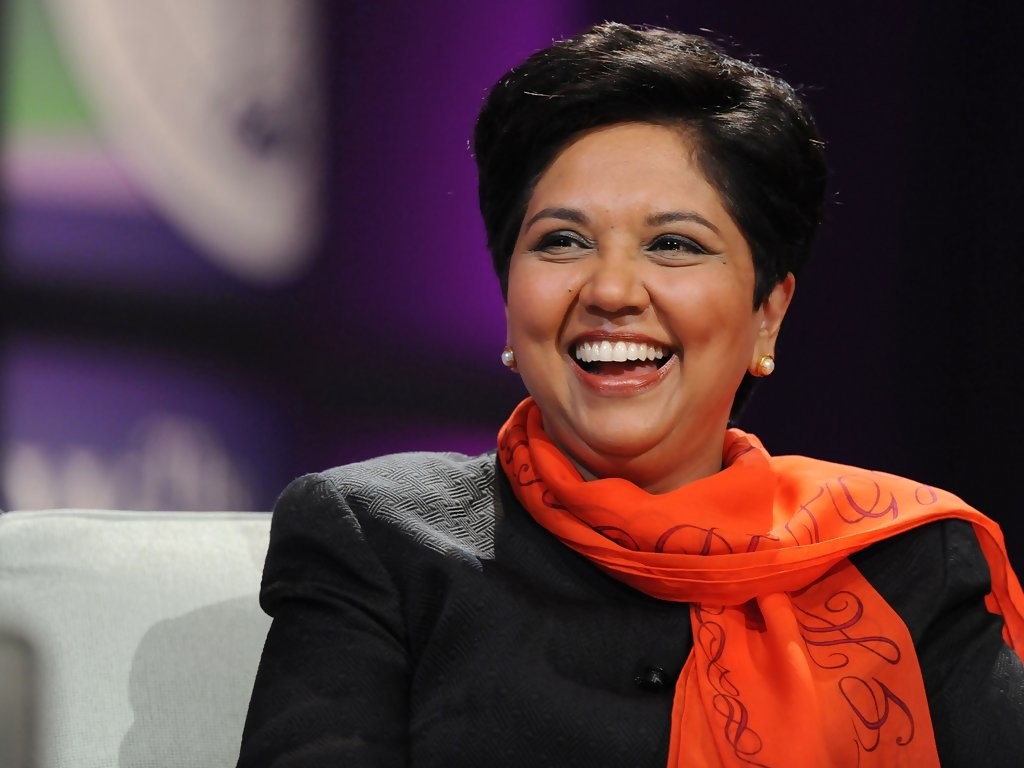
14th most powerful woman in the World according to Forbes (2016), Indra Nooyi was appointed as the Chief Executive Officer of PepsiCo in 2006. Her secret recipe to success is what she calls 5Cs:
Competency, Courage and Confidence, Communication, Consistency, and Compass.
Only Soft Drinks? Wrong!
When Nooyi first became CEO, she introduced a new company vision, “Performance with Purpose”. It is built on three pillars: Human Sustainability, Environmental Sustainability, and Talent Sustainability. It aims to deliver sustained financial performances through innovative ways that minimize the impacts on the environment. Moreover, Nooyi wanted her company to shift from the traditional soft drink market. She told investors that focusing solely on carbonated beverages was “a thing of the past,” and that emphasizing healthier products would “future-proof” Pepsi’s portfolio. Her strategy was risky and for several years seemed unprofitable. However, the results in the last two years could testify that she is on the correct path.
People First
As a first step to achieving her Vision, Nooyi shuffled some top management positions, aligning the various management levels. She redefined the structure of the company creating three operating units: PepsiCo American Foods, PepsiCo Americas Beverages, and PepsiCo International. In 2012, Nooyi also restructured the global management team and created some new executive positions. Diversity and an inclusive workplace culture helped PepsiCo attract the best talent, build employee engagement, nurture creativity, and empower innovation. Nooyi does not only focus on bonding with key employees but also emphasises interacting with employees’ parents. In 2006, she decided to write personal letters to each of her direct reports’ parents to recognize the good job of her employees.
The Design-Driven Lady

Nooyi truly believes that design is the weapon Pepsi can use to beat the competition of Coca-Cola. She emphasised on design in product manufacturing, packaging, and labeling. Under her leadership, PepsiCo has become more design-driven, meaning that design has become one of the concerns in every important decision in the company. Nooyi visits the supermarket every week and stands in front of the shelves to “listen to what the products are to trying to tell her”. She said she does it to check out how PepsiCo’s products are arranged on the shelves, always doing self-reflection from consumers’ point of view.
One Touch Away
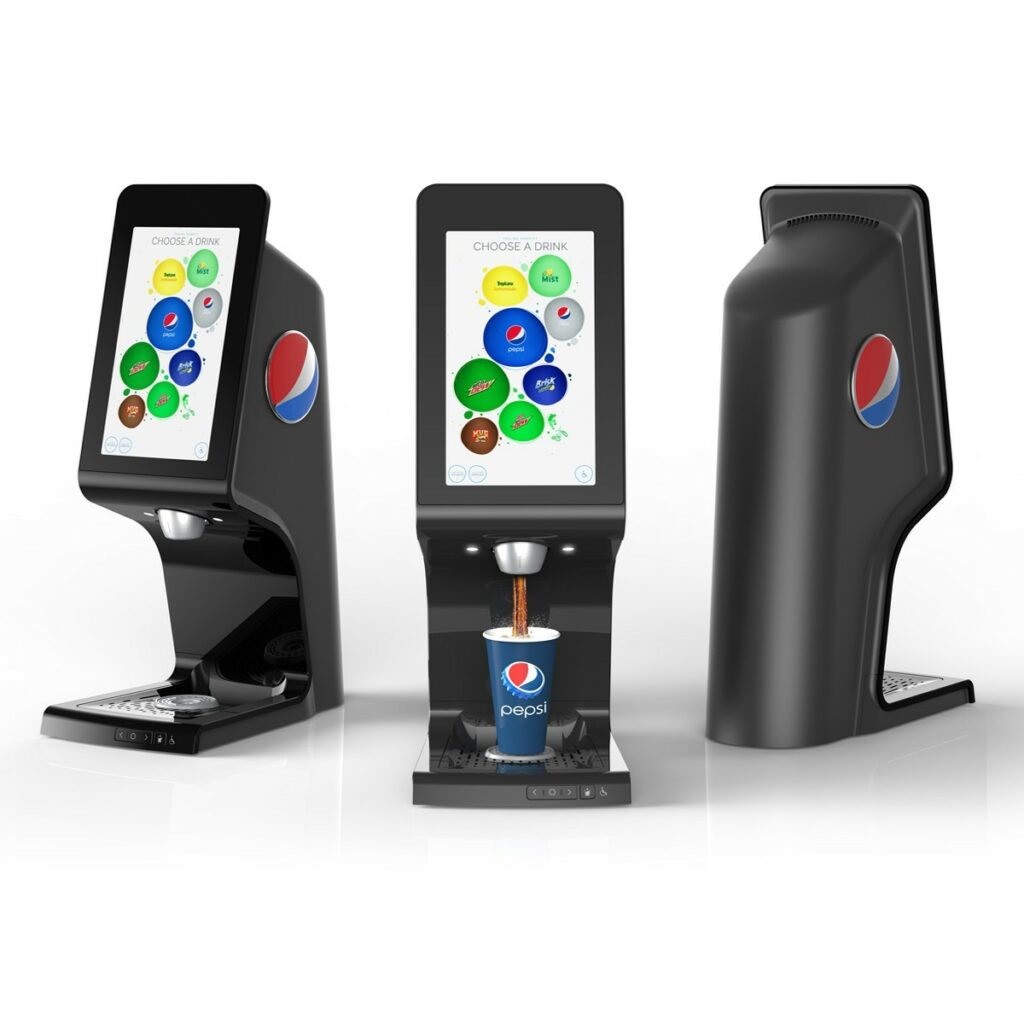
In her strategic plan, Nooyi identified customer experience as the main driver for innovation. PepsiCo has rethought product shape, packaging, and functions to satisfy consumers’ needs. PepsiCo introduced Pepsi Spire, a new touchscreen fountain machine that allows to customise beverages with the touch of a button. It has a gigantic iPad on a futuristic machine that talks to consumers and invites them to interact with it. When consumers swipe their card, it can track the flavor combination that they tried previously and suggest new flavors. Launched in October 2015, NSPIRE is the PepsiCo’s kitchen on wheels. Other than serving restaurant-quality delicious dishes, it allows consumers to create up to 500 customised drinks using a combination of PepsiCo beverages like Pepsi, Mountain Dew, and others.
Going Global

In order to save costs and expand the product portfolio, there were some big acquisitions during Nooyi’s tenure. In 2010, PepsiCo completed the $7.8bn strategic acquisitions of two bottlers, The Pepsi Bottling Group and PepsiAmericas. In the same year, PepsiCo expanded in Russia through the acquisition of Wimm-Bill-Dann Dairy and Juice Company. In 2011, PepsiCo acquired Mabel, positioning itself as a leading company in the snack segment in Brazil.
The Best Has Yet To Come
During Nooyi’s tenure, PepsiCo’s total revenue annual growth rate has been 6.7% while the net income growth rate showed minimal changes. However, apparently poor financial results can be explained by considering the strong shift to healthier products perpetuated by Nooyi. Nowadays, only 25% of PepsiCo’s revenues derive from soda drinks and healthy products can represent the basis for sustainable growth in the future. Moreover, Nooyi focused on her people, aligning them with a new vision. She realized relevant acquisitions and boosted design.
Here we are with our last article about Coca-Cola and Pepsi. After drawing the Leadership profiles of Muhtar Kent and Indra Nooyi, it is finally time to visualize them!
To do so, we will use one of the most important Blue Ocean Leadership (BOL) tools: the “As-is” Leadership Canvas. In contrast with conventional leadership approaches, Blue Ocean Leadership focuses on leadership acts and activities to boost teams’ motivation and improve business results. The “As-is” Leadership Canvas is a visual that shows how much time and effort the leader puts in for each leadership act. It can be built for any company with the aim of uncovering how people experience current leadership and starting a companywide conversation about what leaders do and should do.
In Exhibit 1, we compared the Leadership Canvases of Muhtar Kent and Indra Nooyi.
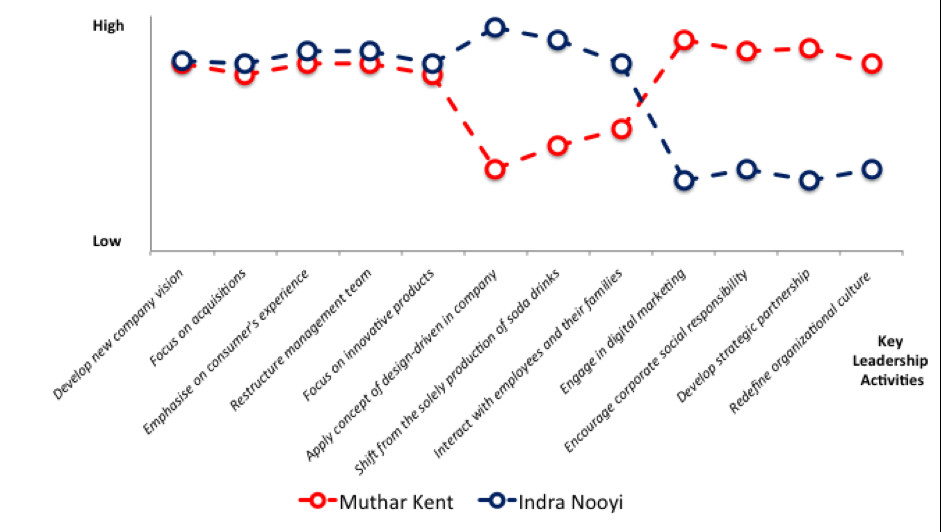
Similar Moves…
Both leaders showed different focuses on their leadership activities but with some common points. Both of them developed new company visions when they first became CEO. Kent introduced the 2020 Vision while Nooyi brought in Performance with Purpose. To achieve their visions, they restructured the management team, filling the line with new people. Furthermore, Muhtar Kent and Indra Nooyi made several acquisitions during their tenure to expand the product portfolios and to cut costs. Both companies developed new healthy beverages and emphasised on customers’ experience.

… But Distinctive Features
Kent and Nooyi showed distinctive features that define them as unique leaders. Nooyi applied design-driven concepts to PepsiCo and design became one of the key factors to compete with Coca-Cola. In addition, she tried to shift from the traditional production of soda, investing in new segments, such as water bottling and snacks. Nowadays, carbonated drinks production constitutes only 25% of PepsiCo’s revenue. On the other hand, Kent focused on digital marketing and corporate social responsibility. He successfully tried to change the company culture leading his employees by example and developing strategic partnerships with different organisations across business, government, and civil society.
Feel free to contact us should you be interested in running a Blue Ocean Leadership (BOL) workshop and discover how it can improve your working environment, your employees’ engagement, and the profitability of your company.


